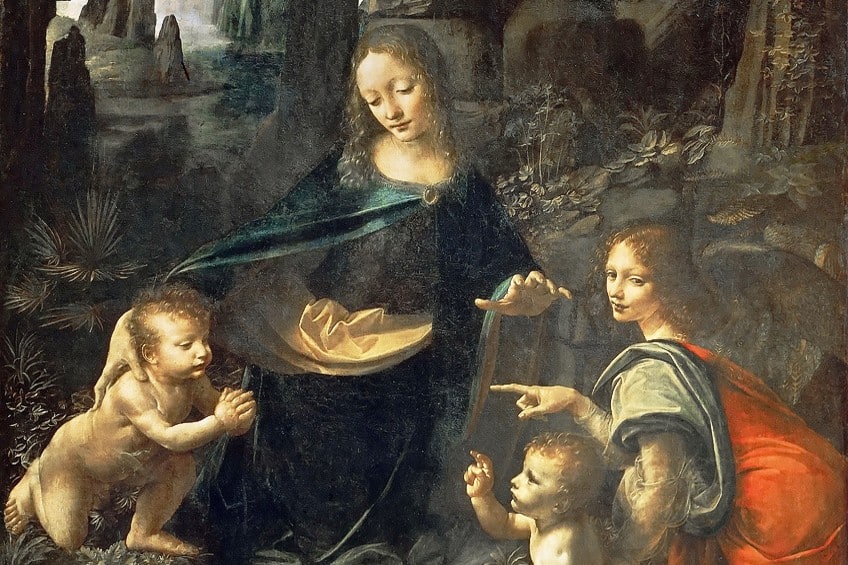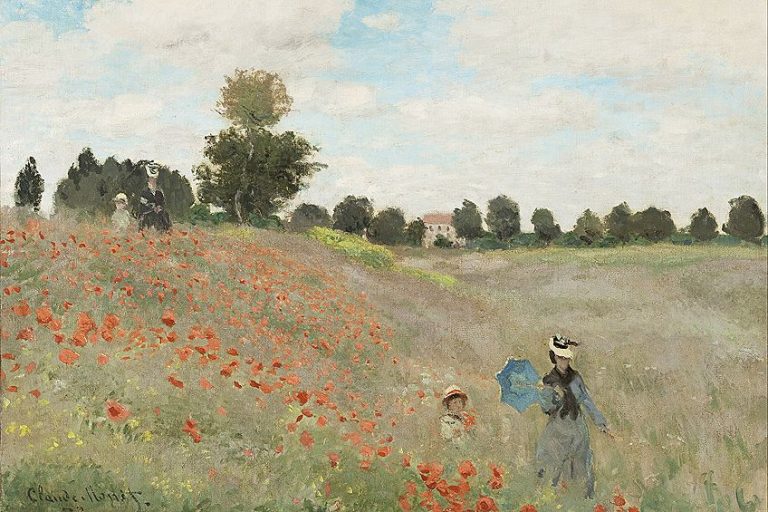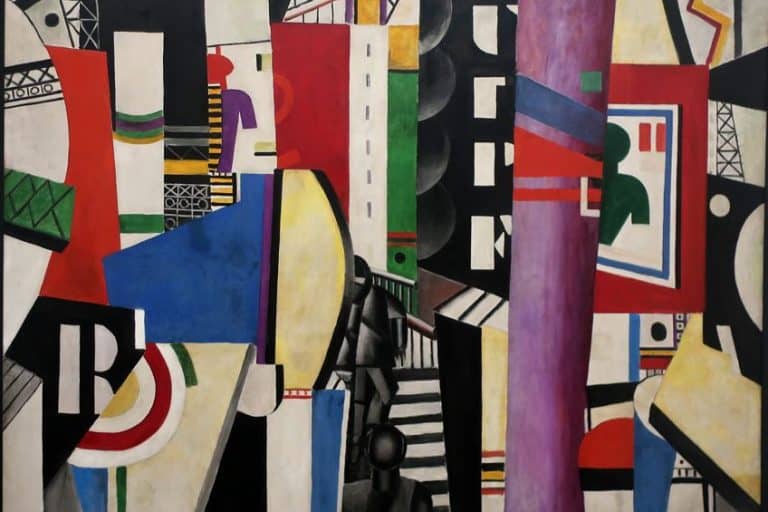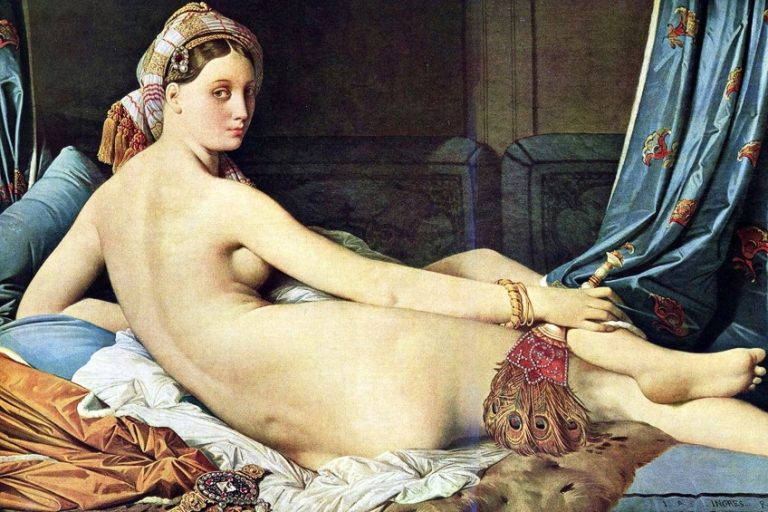“Virgin of the Rocks” by Leonardo da Vinci – The Iconic Artwork
It makes up not one, but two of Western art’s most mysterious paintings – the Virgin of the Rocks artworks by the illustrious Leonardo da Vinci. There is much debate over the meaning and symbolism of the subject matter and further debate over the provenance and artists behind it. Oh, and did we mention that there are two of these paintings? Delve into its cave-like depths and learn more about this painting in the article below.
Artist Abstract: Who Was Leonardo da Vinci?
Leonardo da Vinci was an Italian painter, sculptor, engineer, architect, and more. He was born on April 15, 1452, in the town called Vinci in Florence, Italy, and died on May 2, 1519, at the Château du Clos Lucé in France.
He was known as one of the leading painters of the High Renaissance, as well as a polymath and genius.

Among numerous inventions and techniques, he produced hundreds of sketches and paintings among some of the most popular including The Vitruvian Man (c. 1485), The Last Supper (c. 1492 – 1498), and the Mona Lisa (c. 1503 – 1516).
Virgin of the Rocks (1483 – 1486) by Leonardo da Vinci in Context
| Artist | Leonardo da Vinci |
| Date Painted | 1483 – 1486 |
| Medium | Oil on panel (transferred to canvas in 1806) |
| Genre | Religious painting |
| Period/Movement | High Renaissance |
| Dimensions (cm) | 199 x 122 |
| Series/Versions | First of two versions. The second version is also titled Virgin of the Rocks (c. 1491 – 1508). |
| Where Is It Housed? | Musée du Louvre in Paris, France. The second version is located at the National Gallery in London, England. |
| What It Is Worth | The exact price is uncertain. |
There are two versions of the painting Virgin of the Rocks by Leonardo da Vinci. What is believed to be the first was painted between 1483 to 1486 and is now at the Musée du Louvre in Paris; the second version is at the National Gallery in London and was painted between 1491 to around 1508.
Both versions are alike in subject matter with some minor differences.
The Virgin of the Rocks painting analysis below will focus on the version in the Louvre Museum. It will start with a contextual analysis, discussing the commissioning of his masterpiece and why Da Vinci painted another iteration, and then a visual description of the subject matter.
Contextual Analysis: A Brief Socio-Historical Overview
Leonardo da Vinci, who painted Madonna of the Rocks, otherwise known as Virgin of the Rocks, was reportedly commissioned on April 25, 1483, by the Confraternity of the Immaculate Conception, which is a brotherhood towards the veneration of the “Immaculate Conception” of the Virgin Mother Mary, to paint an image of the Virgin Mother Mary and Jesus Christ. It was for the central panel of a wooden altarpiece built by Giacomo del Maino, for the Chapel of the Conception; the chapel was part of the Church of San Francesco Grande in Milan, Italy.
The two brothers, Evangelista and Ambrogio de Predis were also contracted to paint parts of the altarpiece.
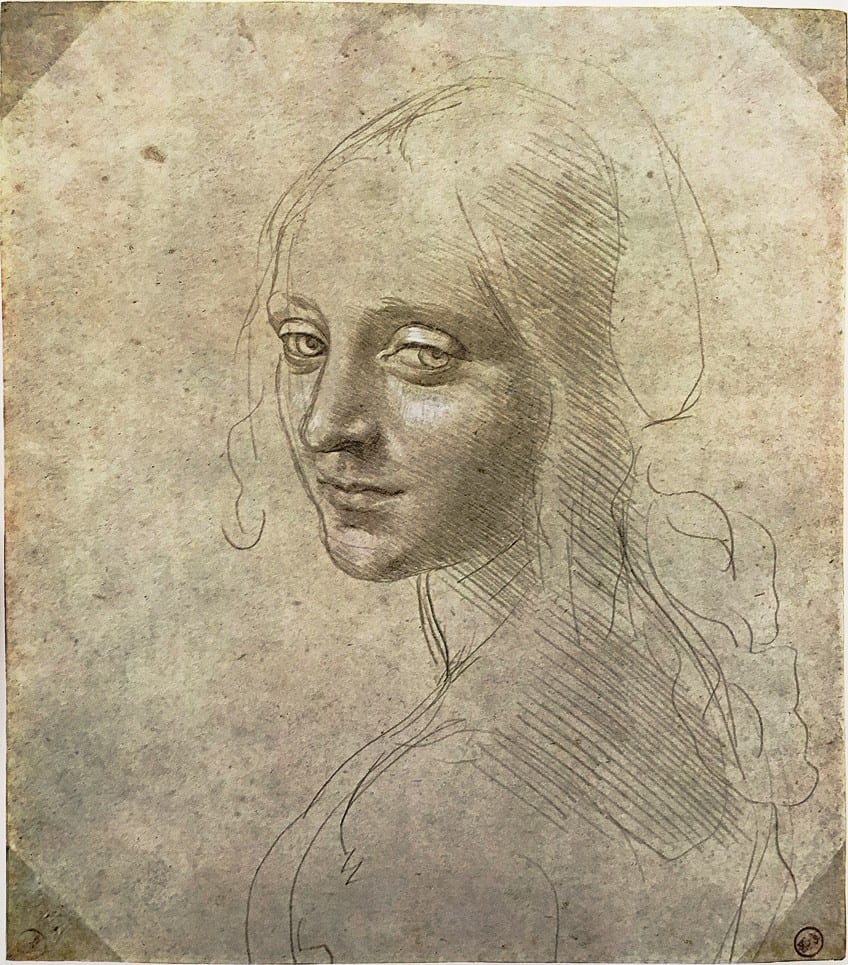
A Virgin of the Rocks Version Controversy
It was believed that the second version of the Virgin of the Rocks painting in the National Gallery in London was the painting that found its way to the altarpiece. So, you are probably wondering why, and what the events are around the initial version of this painting. It is unclear exactly what may have been the cause, but many scholars report that Da Vinci, along with Ambrogio de Predis, may have had financial disagreements with their commissioners over sufficient payment. This was also ascertained through a letter that Da Vinci wrote to the Brotherhood.
Other reports suggest that the commissioners were not satisfied with the first iteration and that after it was assessed it was perceived as not finalized. Furthermore, Da Vinci was believed to have sold the painting only to create a new version, reportedly over 20 years later, for the altarpiece after he and the Confraternity reportedly made amends on the matter.

Although the exact details and factual evidence of the first version’s provenance are uncertain, it was reportedly sold to the Duke of Milan, Ludovico Sforza, who was Da Vinci’s art patron. He was also approached to assist Da Vinci financially regarding the payments of the commission. Reportedly, in the year 1625, the painting was seen by Cassiano dal Pozzo at the Château de Fontainebleau in France.
It is also debated that the second “Virgin of the Rocks” was painted by other artists and not entirely by Da Vinci himself; reportedly the artist was assisted by pupils Giovanni Antonio Boltraffio and Marco d’Oggiono.
There are several stylistic differences in the second version that hints at someone else’s hand behind the paintbrush. Notably in the sizes of the figures and their facial expressions. The “soft” essence felt and conveyed by the first version is not as present in the second version either. Furthermore, the foliage in the second version is reportedly not as accurate as it is in the first.
The Virgin of the Rocks and Its Side Panels
For a broader contextual understanding, the side panel paintings that accompany the Virgin of the Rocks at the National Gallery in London are namely, The Angel in Green with a Vielle (c. 1483) and the Angel in Red with a Lute (c.1483). It is also debated among scholars as to who the artist was for these, some say it was Evangelista and Ambrogio de Predis, Marco d’Oggiono, or Francesco Napoletano.
Formal Analysis: A Brief Compositional Overview
The Virgin of the Rocks painting analysis will discuss the subject matter further by providing a visual description of the scene and how the elements of art arrange the composition. It is important to note, this analysis will discuss the first version of Virgin of the Rocks (1483 – 1486), held at the Louvre Museum in Paris.

Subject Matter: Visual Description
The painting Virgin of the Rocks by Leonardo da Vinci depicts four figures in the foreground, each sitting and kneeling. The central figure is the Mother Mary, who appears to be kneeling. To her right (the viewers’ left) is the infantile figure of Saint John the Baptist. Mary’s right arm and hand are positioned around his small upper back area, gently keeping him under her wing, so to say. He is in a kneeling position, on the hunch of his left leg and kneeling on his right knee. His hands are held palm to palm in a gesture of prayer aimed at the infantile figure of Jesus Christ opposite him.
To Mary’s left (the viewers’ right) is the figure of an angel, who appears to be seated. His wings are barely visible. Similarly, to the angel’s left is the infantile figure of Jesus Christ, who is also seated.
Mary’s left hand is lifted and held above Jesus Christ’s head. The angel’s right index finger is pointing towards Saint John’s figure and its left hand is gently held on Jesus Christ’s back, appearing to support him as he sits. The angel also has a downward gaze and its eyes appear to be gazing toward the figure of Jesus.
Interestingly, the angel is depicted without a pointed finger in the Virgin of the Rocks at the National Gallery in London. In that second version the angel’s right hand is lowered and it has more of a meditative and somewhat removed gaze. Looking at the figure of Jesus, who sits closest to the viewers in the foreground; he is holding up his right index and middle finger in a gesture of blessing to Saint John the Baptist while steadying himself with his left hand on the rocks next to him.

The setting around the four figures is unknown, craggy, and rocky. They appear to be in a cave-like environment, which is further suggested by the expanse of sky along the curved top edge of the composition. Furthermore, the figures appear to be near a body of water, which is visible in the immediate foreground where they are seated as well as in the background where it appears to be originating, either flowing in from a river or ocean outside.
There are various plants in the immediate foreground including plants growing around the rocky formations behind the figures. Reportedly, Da Vinci painted the foliage with botanical correctness.
According to scholars, some of the plants include a palm, visible behind the figure of Saint John the Baptist, which is believed to symbolize Mother Mary, primrose near Jesus Christ’s knee area, and near his feet cyclamen, additionally, it has been noted that the plant near Mother Mary’s head (our right) is a columbine.
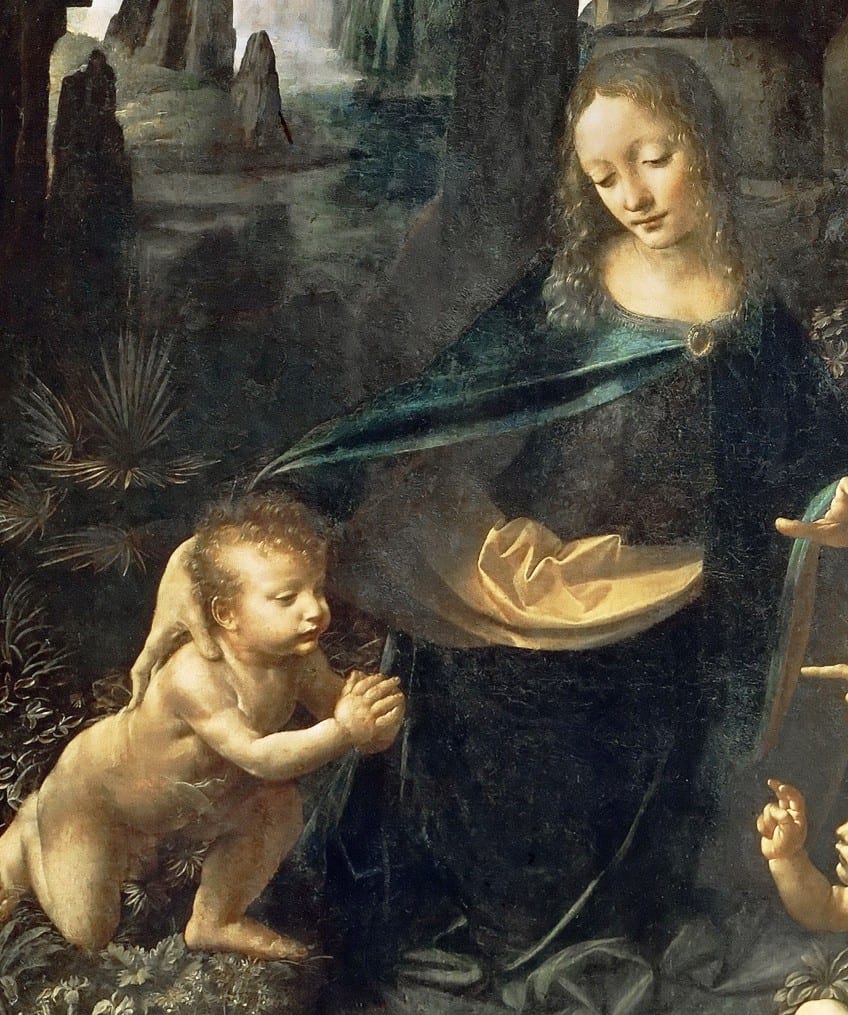
What makes Leonardo da Vinci’s Virgin of the Rocks so unique is how he portrayed the figures in their environment, including their environment. He did not depict the traditional halos on the figures, which were standard features during earlier art of the Middle Ages. Reportedly, the symbolism of the scene points to the Virgin Mary’s purity, and the cave-like setting could suggest the idea of a womb-like space. Alternatively, it can also symbolize Biblical ideas of refuge or safe sheltering.
The depicted environment itself could have originated from Da Vinci’s own experiences when he visited a rocky place and found a cavern.
This experience reportedly left an impression on him and could have contributed to why he created a similar appearing space in the painting. However, it is important to remember that there can be several possible underlying inspirations and influences attached to Da Vinci’s artwork, which can be tied to Biblical and non-Biblical references. There are also numerous questions and interpretations around this painting regarding hidden meanings and messages.
Color
The Virgin of the Rocks by Leonardo da Vinci depicts naturalistic colors, for example, the earthy browns of the rocks and the variety of greens of the foliage. There is also the red from the angel’s robe and what appears to be a deeper green/blue of Mother Mary’s robes. Da Vinci also depicted delicate and light skin tones.
There is also a utilization of the famous “chiaroscuro” and “sfumato” techniques Da Vinci was well-known for, which is typically described as the “blending” of colors to change from tone to tone and light to dark and vice versa.
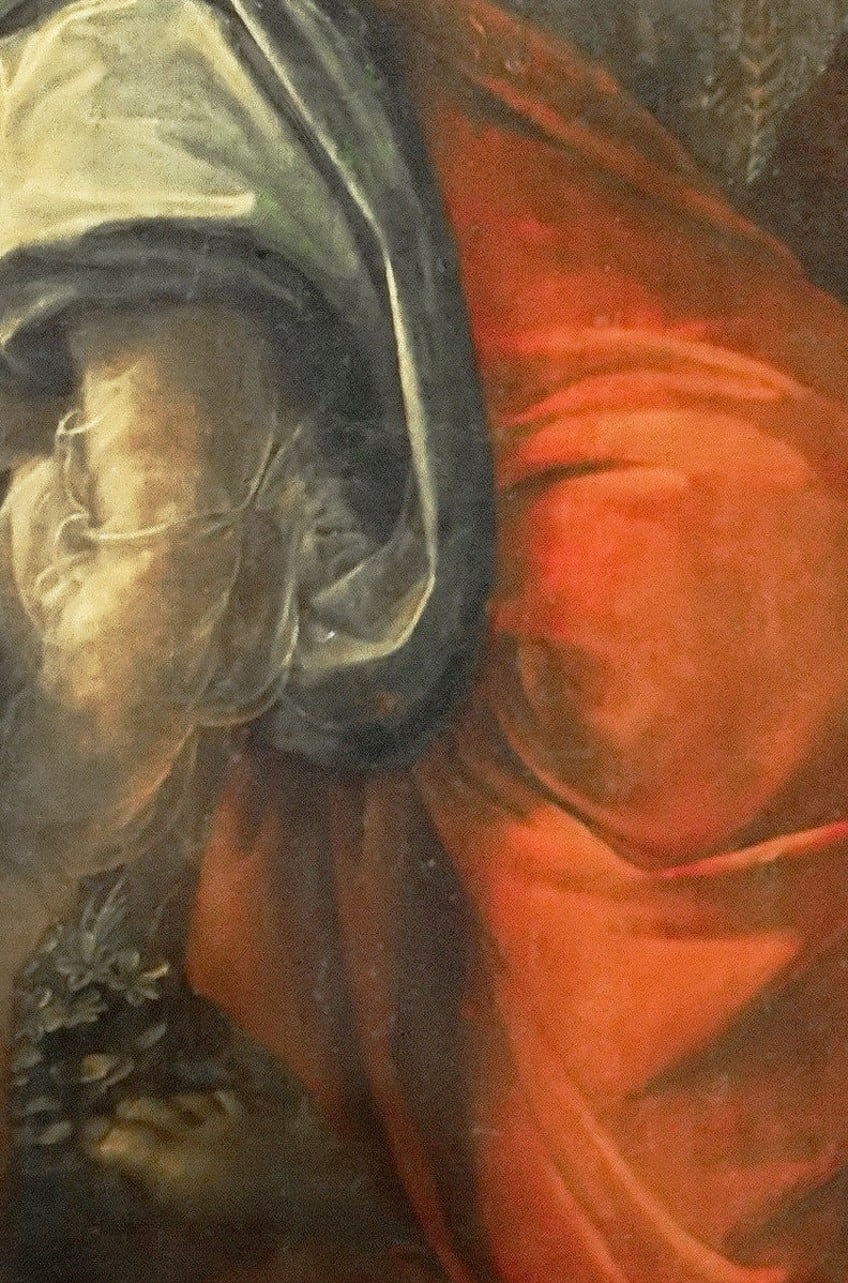
For example, notice the dark and light transitions notably the lighter foreground, which appears as if there is a light source on the figures, and the darker background, the shadows created by the rocky structures that are also emphasized by the light behind them in the far distance.
Texture
Leonardo da Vinci conveyed the idea of texture to match the subject matter in Virgin of the Rocks, for example, the four figures’ smooth skin tones, the soft folds of the robes, and even softer curls of their hair. Mother Mary’s robe also appears to be velvet material. These are somewhat contrasted by the harder surface texture of the rocks.
Additionally, notice the reflective surface of the water in the background, which appears somewhat calm and crystalline.

Line
There is a naturalism in the Virgin of the Rocks painting and Leonardo da Vinci did not convey any visible outlines around the subject matter. There appears to be a natural transition between the different forms that are created by Da Vinci’s skilled utilization of color and his sfumato technique.
The lines are organic and irregular, as would only naturally be found in real-life figures or foliage.
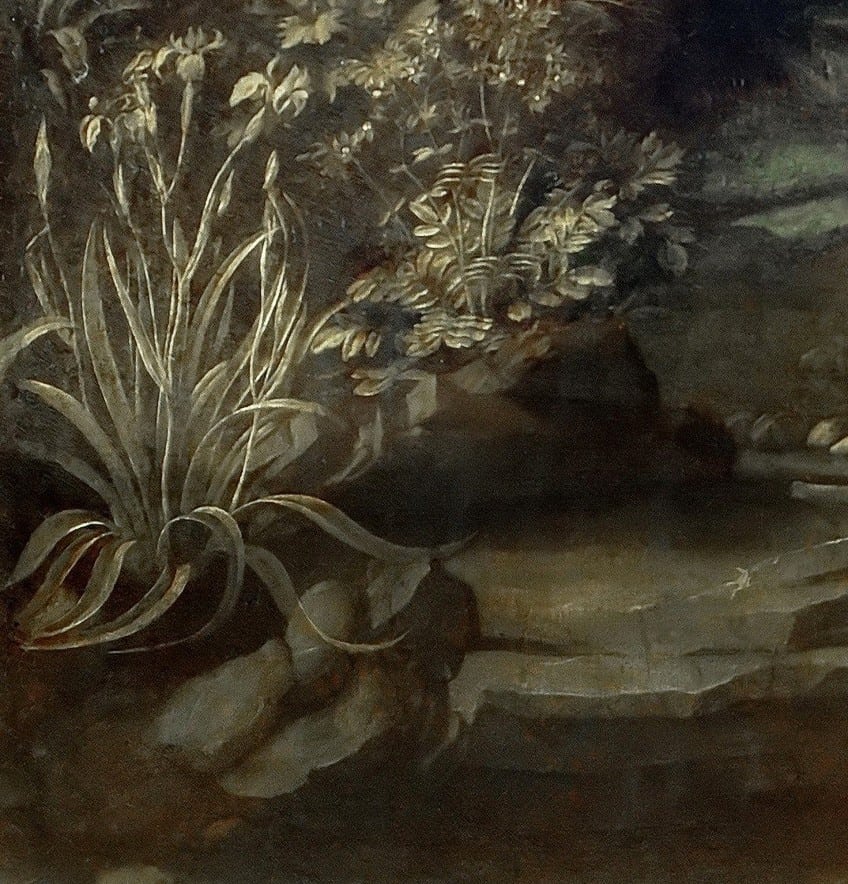
Shape and Form
The composition of Virgin of the Rocks by Leonardo da Vinci is mostly composed of naturalistic (or organic) forms. However, a subtle contrast is noticed between the figures in the foreground, who appear more fluid in form compared to the angularity of the rocky structures behind them.
The rocks in the background still maintain a level of organic form because of their irregularity of form.

Space
Space in the Virgin of the Rocks painting by Leonardo da Vinci is created through a sense of depth, which is created through other art elements like color and as previously mentioned, shading techniques like sfumato. Da Vinci further created a sense of depth through spatial aspects like aerial perspective, which is the blurring of the distant subject matter.
Notice how much smaller and slightly more blurrier the rock formations in the background appear. This is even more visible in Da Vinci’s second iteration of the “Virgin of the Rocks” painting.
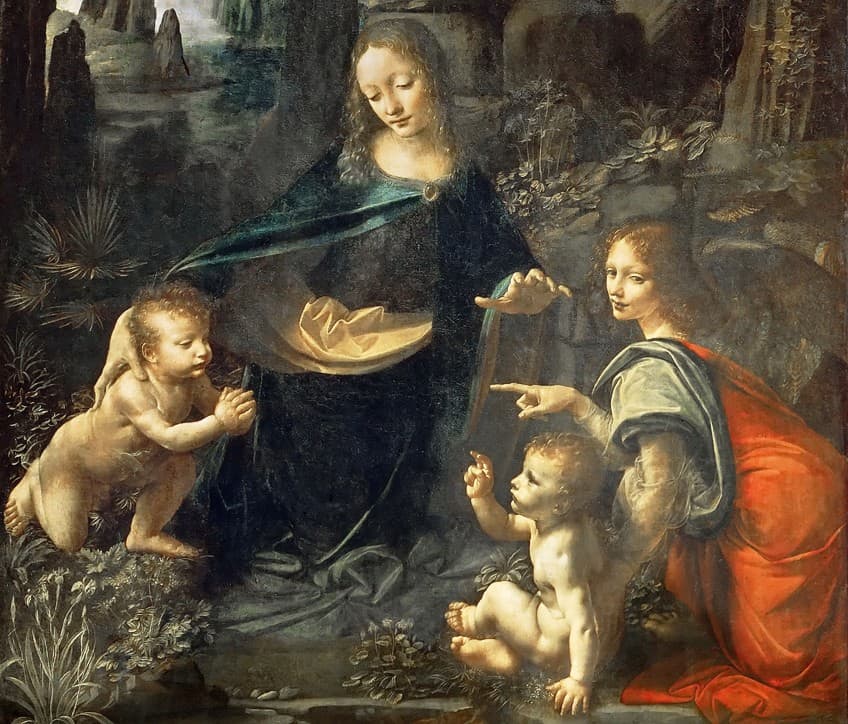
Da Vinci’s four figures are arranged in a pyramidal structure, which reportedly creates more spatial depth and three-dimensionality. The top of the pyramid is at Mother Mary’s head, the right side of the pyramid is around Jesus Christ’s left arm and the angel’s robe, and the left side of the pyramid is around Saint John the Baptist’s body. This structure also connects the figures and the composition. A sense of three dimensions is also created in how Da Vinci foreshortened Mother Mary’s left hand above Jesus Christ’s head. It provides the composition with a sense of realism as if the figures are fluid and moving within their space.
One Genius, Two Brothers, and Two Paintings
While there is much more to say about Leonardo Da Vinci’s Virgin of the Rocks painting and enough information and speculation that could fill a whole book, this article touched on some of the important historical information surrounding these Renaissance masterpieces.
They are now housed in two different museums, namely what is believed to be the first version in the Musée du Louvre in Paris and the second version in the National Gallery in London.

The “Virgin of the Rocks” painting is among one of the finest High Renaissance artworks, with its religious symbolism and pictorial realism co-existing on canvas, making it quite a unique and novel expression for the 15th century. It was one of Leonardo da Vinci’s genius and iconic examples of bringing the unseen realms of religion and spirit into the seen and transporting us, the viewers, to a new realm altogether.
Frequently Asked Questions
Who Painted Madonna of the Rocks?
The Renaissance artist Leonardo da Vinci painted the oil panel Madonna of the Rocks from 1483 to 1486. It is also known as the Virgin of the Rocks and measures 199 x 122 centimeters. It is held at the Musée du Louvre in Paris, France.
What Is the Location of the Virgin of the Rocks by Leonardo da Vinci?
The painting, Virgin of the Rocks, by Leonardo da Vinci is located at the Musée du Louvre in Paris, France. A second version, similarly titled, was reportedly painted by other artists that worked with Da Vinci and possibly under his guidance, namely Marco d’Oggiono or Giovanni Antonio Boltraffio. It was painted around 1491 to 1508 and is located at the National Gallery in London, England.
Who Are the Figures in the Virgin of the Rocks by Leonardo da Vinci?
Both of Leonardo da Vinci’s paintings, namely Virgin of the Rocks (1483 – 1486) at the Musée du Louvre in Paris and Virgin of the Rocks (c. 1491 – 1508) at the National Gallery in London, are believed to depict the figures of Mother Mary, Jesus Christ, Saint John the Baptist, and the Archangel Uriel (although the latter is questioned as it could possibly be Archangel Gabriel).
Alicia du Plessis is a multidisciplinary writer. She completed her Bachelor of Arts degree, majoring in Art History and Classical Civilization, as well as two Honors, namely, in Art History and Education and Development, at the University of KwaZulu-Natal, South Africa. For her main Honors project in Art History, she explored perceptions of the San Bushmen’s identity and the concept of the “Other”. She has also looked at the use of photography in art and how it has been used to portray people’s lives.
Alicia’s other areas of interest in Art History include the process of writing about Art History and how to analyze paintings. Some of her favorite art movements include Impressionism and German Expressionism. She is yet to complete her Masters in Art History (she would like to do this abroad in Europe) having given it some time to first develop more professional experience with the interest to one day lecture it too.
Alicia has been working for artincontext.com since 2021 as an author and art history expert. She has specialized in painting analysis and is covering most of our painting analysis.
Learn more about Alicia du Plessis and the Art in Context Team.
Cite this Article
Alicia, du Plessis, ““Virgin of the Rocks” by Leonardo da Vinci – The Iconic Artwork.” Art in Context. June 9, 2023. URL: https://artincontext.org/virgin-of-the-rocks-by-leonardo-da-vinci/
du Plessis, A. (2023, 9 June). “Virgin of the Rocks” by Leonardo da Vinci – The Iconic Artwork. Art in Context. https://artincontext.org/virgin-of-the-rocks-by-leonardo-da-vinci/
du Plessis, Alicia. ““Virgin of the Rocks” by Leonardo da Vinci – The Iconic Artwork.” Art in Context, June 9, 2023. https://artincontext.org/virgin-of-the-rocks-by-leonardo-da-vinci/.


